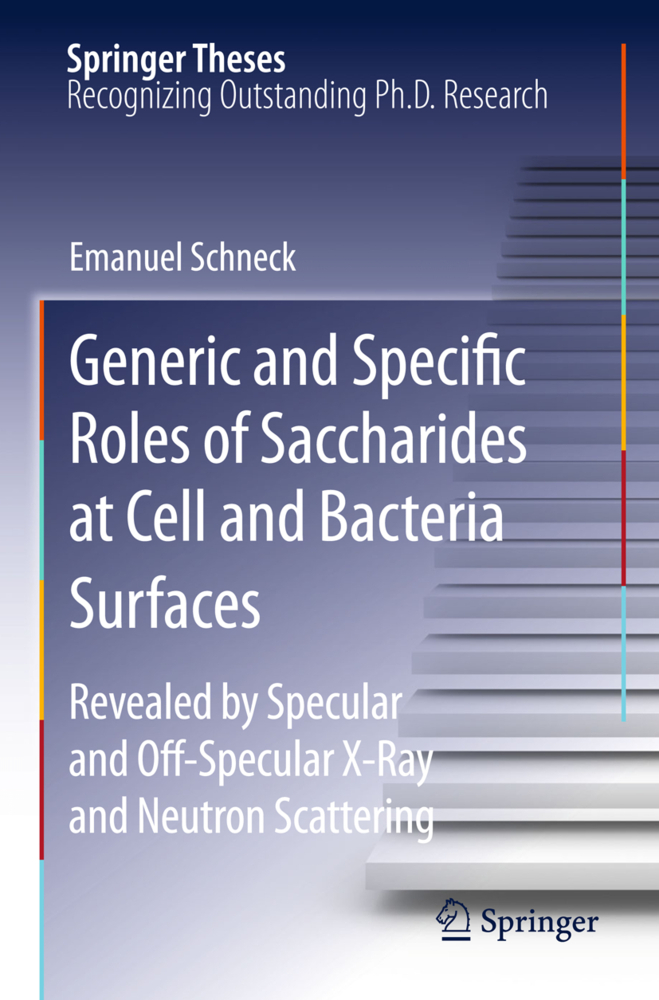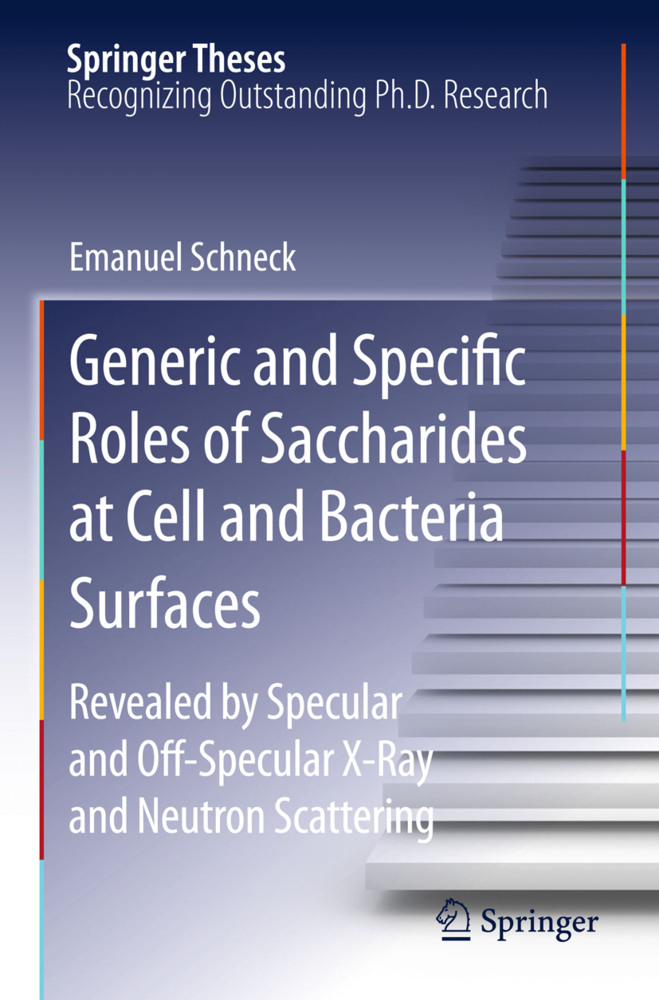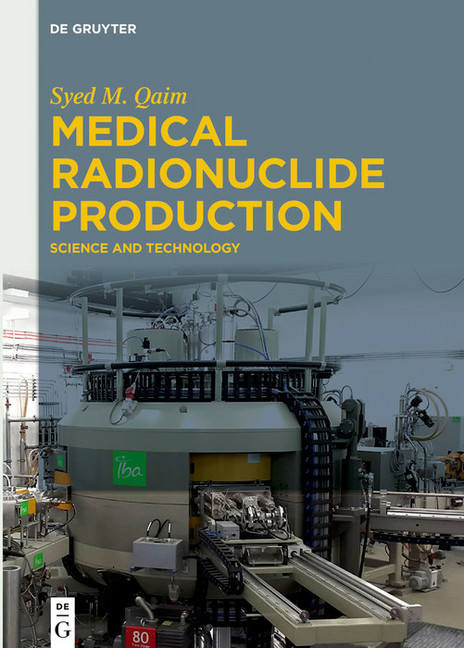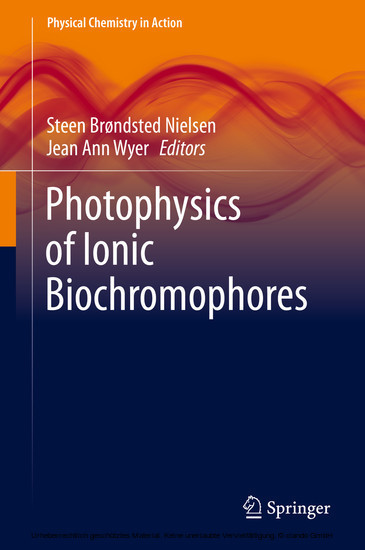Generic and Specific Roles of Saccharides at Cell and Bacteria Surfaces
Revealed by Specular and Off-Specular X-Ray and Neutron Scattering
Generic and Specific Roles of Saccharides at Cell and Bacteria Surfaces
Revealed by Specular and Off-Specular X-Ray and Neutron Scattering
Systematic investigations of the structure, mechanics, and dynamics of biological surfaces help us understand more about biological processes taking place at cell and bacteria surfaces. Presented here is a study of the role membrane-bound saccharides play in the modulation of interactions between cells/bacteria and their environments. In this thesis, membrane structures were probed perpendicular and parallel to the surface, and sophisticated planar models of biomembranes composed of glycolipids of various structural complexities were designed. Furthermore, specular and off-specular X-ray and neutron scattering experiments were carried out. This research has led to the development of several new methods for extracting information on the structure and mechanics of saccharide-rendered biomembranes from the measured scattering signals. In fact, more is now known about the influence of the saccharide structure. These results demonstrate that the study of planar model systems with X-ray and neutron scattering techniques can provide comprehensive insight into the structure and mechanics of complex biological surfaces.
1;Generic and Specific Roles of Saccharides at Cell and Bacteria Surfaces;3 1.1;Supervisor's Foreword;8 1.2;Acknowledgments;10 1.3;Contents;11 1.4;1 Introduction;14 1.4.1;References;18 1.5;2 Theoretical Background;21 1.5.1;2.1...Lipid Membranes;21 1.5.1.1;2.1.1 Physics of Lipids and Lipid Membranes;21 1.5.1.1.1;2.1.1.1 Membrane Formation by Lipid Self-Assembling;21 1.5.1.1.2;2.1.1.2 Phase Behavior of Lipid Membranes;23 1.5.1.2;2.1.2 Inter-Membrane Interactions;24 1.5.1.2.1;2.1.2.1 Hardcore Repulsion;25 1.5.1.2.2;2.1.2.2 Van der Waals Interaction;25 1.5.1.2.3;2.1.2.3 Hydration Repulsion;26 1.5.1.2.4;2.1.2.4 Undulation Repulsion;26 1.5.1.2.5;2.1.2.5 Electrostatic Interaction;27 1.5.1.2.6;2.1.2.6 The Disjoining Pressure;27 1.5.1.2.7;2.1.2.7 Force--Distance Relationships;28 1.5.1.3;2.1.3 Mechanics of Solid-Supported Membrane Multilayers;28 1.5.1.3.1;2.1.3.1 The Discrete Smectic Hamiltonian;28 1.5.1.3.2;2.1.3.2 Height--Height Correlation Functions;30 1.5.1.3.3;2.1.3.3 Membrane Displacement Correlation Functions;31 1.5.1.4;2.1.4 Membrane Models;31 1.5.1.4.1;2.1.4.1 Langmuir Lipid Monolayers;31 1.5.1.4.2;2.1.4.2 Solid-Supported Lipid Monolayers;33 1.5.1.4.3;2.1.4.3 Solid-Supported Lipid Bilayers;33 1.5.1.4.4;2.1.4.4 Solid-Supported Membrane Multilayers;34 1.5.2;2.2...Principles of X-Ray and Neutron Scattering;35 1.5.2.1;2.2.1 Basic Principles;35 1.5.2.1.1;2.2.1.1 X-Ray versus Neutrons;36 1.5.2.1.2;2.2.1.2 Scattering from Oriented Planar Samples;36 1.5.2.2;2.2.2 Specular Scattering;38 1.5.2.2.1;2.2.2.1 Specular Reflectivity from a Single Ideal Interface;38 1.5.2.2.2;2.2.2.2 Interfacial Roughness;40 1.5.2.2.3;2.2.2.3 Stratified Interfaces;41 1.5.2.2.4;2.2.2.4 Periodic Multilayers;42 1.5.2.3;2.2.3 Off-Specular (Diffuse) Scattering;42 1.5.2.3.1;2.2.3.1 Scattering from a Single, Topologically Rough Interface;43 1.5.2.3.2;2.2.3.2 Scattering from Stratified Interfaces with Correlated Topological Roughness;46 1.5.3;References;48 1.6;3 Materials and Methods;51 1.6.1;3.1...Materials;51 1.6.1.1;3.1.1 DPPC and Synthetic Glycolipids;51 1.6.1.1.1;3.1.1.1 DPPC;51 1.6.1.1.2;3.1.1.2 Gentiobiose lipid and Lac1 lipid;51 1.6.1.1.3;3.1.1.3 LeX lipid;52 1.6.1.2;3.1.2 Lipopolysaccharides;53 1.6.1.3;3.1.3 Chemicals and Buffers;54 1.6.1.3.1;3.1.3.1 Calcium-Free Buffers;55 1.6.1.3.2;3.1.3.2 Calcium-Loaded Buffers;55 1.6.2;3.2...Preparation Methods;55 1.6.2.1;3.2.1 Preparation of Solutions/Suspensions;55 1.6.2.1.1;3.2.1.1 DPPC and Synthetic Glycolipids;55 1.6.2.1.2;3.2.1.2 Lipid A and Rough Mutant LPS;55 1.6.2.1.3;3.2.1.3 PAOLPS;56 1.6.2.2;3.2.2 Preparation of Solid-Supported Membrane Multilayers;56 1.6.2.3;3.2.3 Preparation of Rough Mutant LPS Monolayers at the Air/Water Interface;57 1.6.2.4;3.2.4 Preparation of Solid-Supported PAOLPS Monolayers;57 1.6.3;3.3...Scattering Techniques;58 1.6.3.1;3.3.1 X-Ray Scattering;58 1.6.3.1.1;3.3.1.1 Specular X-Ray Reflectivity Experiments;58 1.6.3.1.2;3.3.1.2 GIXOS Experiments at the Air/Water Interface;58 1.6.3.1.3;3.3.1.3 X-Ray Fluorescence Experiments;59 1.6.3.2;3.3.2 Neutron Scattering;60 1.6.3.3;3.3.3 Sample Environments;62 1.6.3.3.1;3.3.3.1 Humidity Chamber for Neutron Scattering under Vapor Conditions;62 1.6.3.3.2;3.3.3.2 Liquid Cell for Neutron Scattering under Bulk Water Conditions;63 1.6.3.3.3;3.3.3.3 Liquid Cell for High-Energy X-Ray Reflectivity Measurements;64 1.6.4;References;64 1.7;4 Theoretical Modeling;67 1.7.1;4.1...Determination of Mechanical Properties of Interacting Membranes;67 1.7.1.1;4.1.1 Membrane Displacement Correlation Functions;67 1.7.1.2;4.1.2 Calculation of Specular and Off-Specular Scattering Signals;69 1.7.1.2.1;4.1.2.1 Beyond the Kinematic Approximation;74 1.7.1.2.2;4.1.2.2 Multiple Scattering;74 1.7.1.3;4.1.3 Summary of Sect. 4.1;76 1.7.2;4.2...Electrostatic Interactions between Charged Lipid Membranes;76 1.7.2.1;4.2.1 A Single Charged Surface in an Electrolyte;77 1.7.2.2;4.2.2 Two Charged Surfaces in an Electrolyte;78 1.7.2.3;4.2.3 The Weak-Overlap Approximation;80 1.7.2.4;4.2.4 Summary
Schneck, Emanuel
| ISBN | 9783642154508 |
|---|---|
| Artikelnummer | 9783642154508 |
| Medientyp | E-Book - PDF |
| Auflage | 2. Aufl. |
| Copyrightjahr | 2010 |
| Verlag | Springer-Verlag |
| Umfang | 128 Seiten |
| Sprache | Englisch |
| Kopierschutz | Digitales Wasserzeichen |











